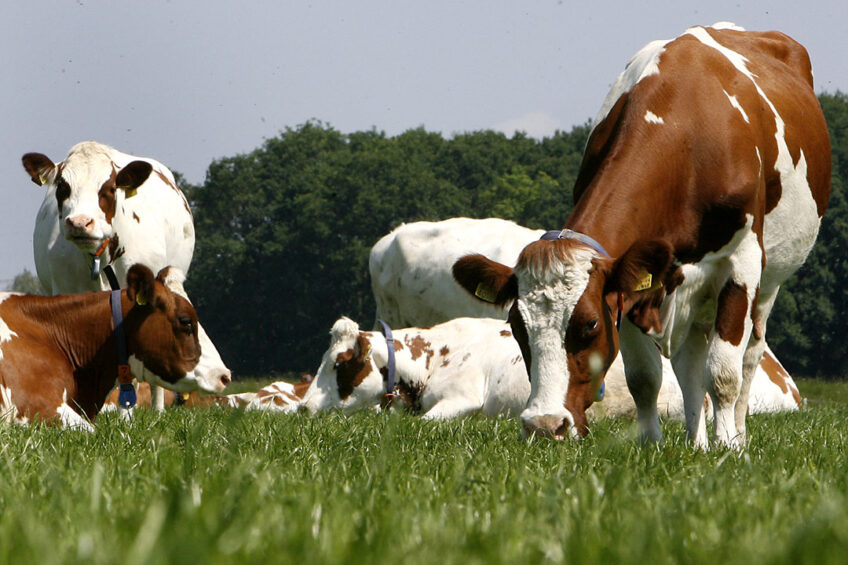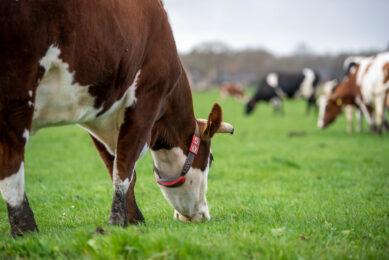Promising efforts to lower enteric methane

Researchers around the world are searching for new ways to lower emissions.
Projects in Denmark and Canada have assessed emissions-lowering measures, and Swiss feed additive company DSM Nutritional Products has developed a new active ingredient that shows great promise.

Danish research
In Denmark, a new project aims to reduce methane emissions via feed and is investigating the biological reasons that cows differ in methane production. Peter Lund, Professor of Sustainable Dairy Production in the Department of Animal Sciences at Aarhus University, is leading the project.
The project will measure methane production, for instance, in cows that are fed the same diet but at different lactation points to see if there are differences.
“If we have these two animals in front of us and one responds a lot and is generally low in methane, what is the reason?” says Lund. “Is it because the rumen microbial community differs? Is it because the animal chews the feed in a different way? Is it because it produces more saliva? That the pH in the rumen differs? Is it because of the rumen size? We don’t really know.”
Knowing how cows respond will help determine which cows will best respond to certain mitigation strategies, says Lund. Furthermore, he believes breeders could then use this information to include lowered methane production in their breeding goals.
 New treatments for digital dermatitis
New treatments for digital dermatitis
Whilst scientists and product developers still do not know all the details about the causal organisms of this persistent disease, treatments are evolving.
The four-year project is in its second year. It is part of a number of projects all aimed at more climate-friendly dairy production. The research is a collaborative effort between Aarhus University, the University of Copenhagen, a few private companies, including DSM Nutritional Products, and SEGES.
Canadian research
In Canada, research led by Dr Karen Beauchemin, a livestock specialist at Agriculture and Agri-Food Canada, is being used to develop methane mitigation strategies to help the country’s dairy sector reduce its impact on the environment.
Like the researchers in Denmark, the Canadian team noted differences in methane production from one cow to another. A high-producing cow averaging 10,250kg of milk per lactation, for example, produces approximately 375g d-1 of methane, while a low-producing cow averaging 500kg of milk produces about 180g d-1 of methane. This loss in methane energy typically represents 5.7–6.5% of total gross energy intake, depending on diet composition and milk production of the cow. The scientists believe that improved understanding of the process of methanogenesis combined with further understanding of how the animal and its diet, feed additives, and management factors impact methanogenesis could lead to development of better methane mitigation strategies.
Improving feeding strategies seems to show the most promise. For instance, it was found that increasing dietary fat in feed reduces energy lost as methane by up to 20%. Tested feed includes crushed oilseeds – such as sunflower seed, canola seed and flaxseed – and dried corn distillers grain.
 Feeding the future: A sustainable approach to dairy farming
Feeding the future: A sustainable approach to dairy farming
What does the science say? What is the data telling us?
Similar reductions were found when whole cottonseed, plant oils and some ethanol by-products were added to the diet. Overall, each percentage point of crude fat added to dietary dry matter reduced methane production by five percentage points, says Beauchemin. While there’s some room to add fat to the diet, she is careful to note that too much fat can impact cattle health and increase production costs.
Beauchemin’s team is also investigating feed additives, including plant extracts (condensed tannins, saponins and essential oil products) and rumen modifiers such as yeast, bacterial direct-fed microbials and enzymes. While essential oils derived from garlic, thyme, eucalyptus, oregano, cinnamon and rhubarb have been shown to decrease methane production in vitro, Beauchemin says there are few controlled research studies that have examined their anti-methanogenic effects. Furthermore, there is some concern that some of the oils may create an off flavour in milk. Further studies are needed before recommendations can be made, she says.
In North America, it is common to feed yeast-based products to high-producing herds in order to improve fibre digestion in the rumen. Improved fibre digestion improves nutrient absorption efficiency.
They don’t directly reduce methane, but they improve feed efficiency,” says Beauchemin.
“You get more energy out of the feed, so you get more milk per kilogramme of feed and you get less methane per kilogramme of milk.”
But the first strategy has to be improving feed quality to improve production efficiency, says Beauchemin. Most improvements can be made in terms of forage by feeding less fibrous and more digestible forage. Methane is the result of poor quality feed fermenting, she says, noting that adding legumes to the diet seems to be beneficial.
DSM – digestive feed additive
There are seven enzymatic steps in a cow’s rumen that convert hydrogen and carbon dioxide into methane. DSM Nutritional Products has developed a digestive feed additive, Bovaer, that blocks that conversion temporarily to inhibit the production of methane using the active ingredient 3-NOP. The effect of 3-NOP is fully reversible in the animal. Once feeding is stopped, methane production goes back to normal. Furthermore, 3-NOP does not kill the micro-organisms that produce methane. It simply minimises their activity. It is also very specific, so it only hits methanogens in the rumen microbial population and nowhere else.
“This is really good from a regulatory perspective – from all kinds of perspectives – because this is also why we don’t see and don’t expect negative consequences,” says Maik Kindermann, director of innovation and technology at DSM.
Feeding just 1–1.5 grammes of Bovaer to each cow daily reduces methane production by 30% or 1 tonne per cow per year, said DSM’s Clean Cow programme director Mark van Nieuwland. Three cows’ worth of reduction is equivalent to removing one car from the road. But the actual reduction of methane is always the result of interplay between the dose of 3-NOP, the diet and the animal being tested, he says.
3-NOP has been widely studied around the world. Trials were conducted in 13 countries in Europe, North America, South America and Oceania, and results have been published in 31 peer-reviewed articles in scientific journals. In a scientific paper published in PNAS in 2016, for example, Evert C. Duin and colleagues concluded that the mode of action is indeed effective.
DSM Nutritional Products filed for market authorisation in Europe in 2019. They expect approval sometime next year.
 4 top tips to tackle heat stress in dairy cattle
4 top tips to tackle heat stress in dairy cattle
Feeling the stress? There are lots of different forms of stress in dairy production.
Holistic approach advised
Each new strategy implemented impacts the overall carbon balance, so promoting one strategy over another could lead to an imbalance in the system. For this reason it is advised that farmers evaluate their entire production system carefully. In some countries, modeling tools help farmers make balanced decisions. But this is, perhaps, why feed additives are an attractive option, as producers do not have to change their diet at all.
Join 13,000+ subscribers
Subscribe to our newsletter to stay updated about all the need-to-know content in the dairy sector, two times a week.


 Interview: Many possibilities to lower emissions through feed
Interview: Many possibilities to lower emissions through feed







